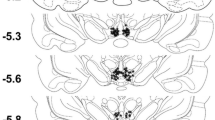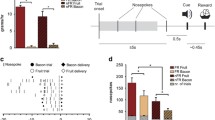Abstract
Rationale
The mesolimbic dopamine system is an important component of the neural circuitry controlling reward-related behavior. We have recently shown that the melanocortin peptides decrease normal homeostatic feeding through actions in the ventral tegmental area. It is unknown, however, whether melanocortin peptides can also act on dopamine pathways to regulate hedonic, reward-related aspects of feeding.
Objectives
In these studies, we tested whether injection of melanocortin receptor agonists directly into the ventral tegmental area (VTA) affected the intake of appetizing and rewarding sugar solutions in two-bottle choice tests.
Methods
Varying doses of the melanocortin receptor agonist, MTII, were injected into the VTA, and the intake of different sugar solutions was measured in two-bottle choice tests to distinguish between potential effects on homeostatic versus hedonic aspects of feeding. In addition, 24-h food intake was measured throughout the experiments.
Results
Injection of MTII into the VTA dose dependently decreased the intake of 1 and 2 % sucrose solutions and 0.2 % saccharin solutions and decreased 24-h food intake in each study. Although MTII also decreased the intake of a 10 % sucrose solution, MTII appeared to be less potent in rats exposed to 10 % sucrose, as only the highest dose of MTII tested was effective at reducing 10 % sucrose intake and food intake in these rats.
Conclusions
These studies demonstrate that melanocortins can act directly in the VTA to control reward-related feeding. Thus, these studies add to the growing body of evidence showing that melanocortins can interact with the mesolimbic dopamine system to regulate multiple reward-related behaviors.







Similar content being viewed by others
References
Adan RA, Szklarczyk AW, Oosterom J, Brakkee JH, Nijenhuis WA, Schaaper WM, Meloen RH, Gispen WH (1999) Characterization of melanocortin receptor ligands on cloned brain melanocortin receptors and on grooming behavior in the rat. Eur J Pharmacol 378:249–258
Aponte Y, Atasoy D, Sternson SM (2011) AGRP neurons are sufficient to orchestrate feeding behavior rapidly and without training. Nat Neurosci 14:351–355
Atasoy D, Betley JN, Su HH, Sternson SM (2012) Deconstruction of a neural circuit for hunger. Nature 488:172–177
Bassareo V, Di Chiara G (1997) Differential influence of associative and nonassociative learning mechanisms on the responsiveness of prefrontal and accumbal dopamine transmission to food stimuli in rats fed ad libitum. J Neurosci 17:851–861
Bassareo V, Di Chiara G (1999) Differential responsiveness of dopamine transmission to food-stimuli in nucleus accumbens shell/core compartments. Neuroscience 89:637–641
Butler AA (2006) The melanocortin system and energy balance. Peptides 27:281–290
Butler AA, Kesterson RA, Khong K, Cullen MJ, Pelleymounter MA, Dekoning J, Baetscher M, Cone RD (2000) A unique metabolic syndrome causes obesity in the melanocortin-3 receptor-deficient mouse. Endocrinology 141:3518–3521
Butler AA, Marks DL, Fan W, Kuhn CM, Bartolome M, Cone RD (2001) Melanocortin-4 receptor is required for acute homeostatic responses to increased dietary fat. Nat Neurosci 4:605–611
Chen AS, Marsh DJ, Trumbauer ME, Frazier EG, Guan XM, Yu H, Rosenblum CI, Vongs A, Feng Y, Cao L, Metzger JM, Strack AM, Camacho RE, Mellin TN, Nunes CN, Min W, Fisher J, Gopal-Truter S, MacIntyre DE, Chen HY, Van der Ploeg LH (2000) Inactivation of the mouse melanocortin-3 receptor results in increased fat mass and reduced lean body mass. Nat Genet 26:97–102
Cone RD (2005) Anatomy and regulation of the central melanocortin system. Nat Neurosci 8:571–578
Cone RD (2006) Studies on the physiological functions of the melanocortin system. Endocr Rev 27:736–749
Davis JF, Choi DL, Shurdak JD, Krause EG, Fitzgerald MF, Lipton JW, Sakai RR, Benoit SC (2011) Central melanocortins modulate mesocorticolimbic activity and food seeking behavior in the rat. Physiol Behav 102:491–495
DiLeone RJ, Taylor JR, Picciotto MR (2012) The drive to eat: comparisons and distinctions between mechanisms of food reward and drug addiction. Nat Neurosci 15:1330–1335
Domingos AI, Vaynshteyn J, Voss HU, Ren X, Gradinaru V, Zang F, Deisseroth K, de Araujo IE, Friedman J (2011) Leptin regulates the reward value of nutrient. Nat Neurosci 14:1562–1568
Domingos AI, Vaynshteyn J, Sordillo A, Friedman JM (2014) The reward value of sucrose in leptin-deficient obese mice. Mol Metab 3:73–80
Fan W, Boston BA, Kesterson RA, Hruby VJ, Cone RD (1997) Role of melanocortinergic neurons in feeding and the agouti obesity syndrome. Nature 385:165–168
Hagan MM, Rushing PA, Pritchard LM, Schwartz MW, Strack AM, Van Der Ploeg LH, Woods SC, Seeley RJ (2000) Long-term orexigenic effects of AgRP-(83–132) involve mechanisms other than melanocortin receptor blockade. Am J Physiol Regul Integr Comp Physiol 279:R47–R52
Heffner TG, Hartman JA, Seiden LS (1980) Feeding increases dopamine metabolism in the rat brain. Science 208:1168–1170
Hernandez L, Hoebel BG (1988) Feeding and hypothalamic stimulation increase dopamine turnover in the accumbens. Physiol Behav 44:599–606
Hsu R, Taylor JR, Newton SS, Alvaro JD, Haile C, Han G, Hruby VJ, Nestler EJ, Duman RS (2005) Blockade of melanocortin transmission inhibits cocaine reward. Eur J Neurosci 21:2233–2242
Huszar D, Lynch CA, Fairchild-Huntress V, Dunmore JH, Fang Q, Berkemeier LR, Gu W, Kesterson RA, Boston BA, Cone RD, Smith FJ, Campfield LA, Burn P, Lee F (1997) Targeted disruption of the melanocortin-4 receptor results in obesity in mice. Cell 88:131–141
Jansone B, Bergstrom L, Svirskis S, Lindblom J, Klusa V, Wikberg JE (2004) Opposite effects of gamma(1)- and gamma(2)-melanocyte stimulating hormone on regulation of the dopaminergic mesolimbic system in rats. Neurosci Lett 361:68–71
Kenny PJ (2011a) Common cellular and molecular mechanisms in obesity and drug addiction. Nat Rev Neurosci 12:638–651
Kenny PJ (2011b) Reward mechanisms in obesity: new insights and future directions. Neuron 69:664–679
Kishi T, Aschkenasi CJ, Lee CE, Mountjoy KG, Saper CB, Elmquist JK (2003) Expression of melanocortin 4 receptor mRNA in the central nervous system of the rat. J Comp Neurol 457:213–235
Klusa V, Svirskis S, Opmane B, Muceniece R, Wikberg JE (1999) Behavioural responses of gamma-MSH peptides administered into the rat ventral tegmental area. Acta Physiol Scand 167:99–104
Krashes MJ, Koda S, Ye C, Rogan SC, Adams AC, Cusher DS, Maratos-Flier E, Roth BL, Lowell BB (2011) Rapid, reversible activation of AgRP neurons drives feeding behavior in mice. J Clin Invest 121:1424–1428
Krashes MJ, Shah BP, Koda S, Lowell BB (2013) Rapid versus delayed stimulation of feeding by the endogenously released AgRP neuron mediators GABA, NPY, and AgRP. Cell Metab 18:588–595
Krugel U, Schraft T, Kittner H, Kiess W, Illes P (2003) Basal and feeding-evoked dopamine release in the rat nucleus accumbens is depressed by leptin. Eur J Pharmacol 482:185–187
Lim BK, Huang KW, Grueter BA, Rothwell PE, Malenka RC (2012) Anhedonia requires MC4R-mediated synaptic adaptations in nucleus accumbens. Nature 487:183–189
Lindblom J, Kask A, Hagg E, Harmark L, Bergstrom L, Wikberg J (2002) Chronic infusion of a melanocortin receptor agonist modulates dopamine receptor binding in the rat brain. Pharmacol Res 45:119–124
Lippert RN, Ellacott KL, Cone RD (2014) Gender-specific roles for the melanocortin-3 receptor in the regulation of the mesolimbic dopamine system in mice. Endocrinology 155:1718–1727
Liu H, Kishi T, Roseberry AG, Cai X, Lee CE, Montez JM, Friedman JM, Elmquist JK (2003) Transgenic mice expressing green fluorescent protein under the control of the melanocortin-4 receptor promoter. J Neurosci 23:7143–7154
Ollmann MM, Wilson BD, Yang YK, Kerns JA, Chen Y, Gantz I, Barsh GS (1997) Antagonism of central melanocortin receptors in vitro and in vivo by agouti-related protein. Science 278:135–138
Palmiter RD (2007) Is dopamine a physiologically relevant mediator of feeding behavior? Trends Neurosci 30:375–381
Paxinos G, Watson C (1998) The rat brain in stereotaxic coordinates, 4th edn
Pothos EN, Creese I, Hoebel BG (1995) Restricted eating with weight loss selectively decreases extracellular dopamine in the nucleus accumbens and alters dopamine response to amphetamine, morphine, and food intake. J Neurosci 15:6640–6650
Roseberry AG (2013) Altered feeding and body weight following melanocortin administration to the ventral tegmental area in adult rats. Psychopharmacology (Berl) 226:25–34
Roselli-Rehfuss L, Mountjoy KG, Robbins LS, Mortrud MT, Low MJ, Tatro JB, Entwistle ML, Simerly RB, Cone RD (1993) Identification of a receptor for gamma melanotropin and other proopiomelanocortin peptides in the hypothalamus and limbic system. Proc Natl Acad Sci U S A 90:8856–8860
Rossi M, Kim MS, Morgan DG, Small CJ, Edwards CM, Sunter D, Abusnana S, Goldstone AP, Russell SH, Stanley SA, Smith DM, Yagaloff K, Ghatei MA, Bloom SR (1998) A C-terminal fragment of Agouti-related protein increases feeding and antagonizes the effect of alpha-melanocyte stimulating hormone in vivo. Endocrinology 139:4428–4431
Samama P, Rumennik L, Grippo JF (2003) The melanocortin receptor MCR4 controls fat consumption. Regul Pept 113:85–88
Sanchez MS, Barontini M, Armando I, Celis ME (2001) Correlation of increased grooming behavior and motor activity with alterations in nigrostriatal and mesolimbic catecholamines after alpha-melanotropin and neuropeptide glutamine-isoleucine injection in the rat ventral tegmental area. Cell Mol Neurobiol 21:523–533
Smith JC, Sclafani A (2002) Saccharin as a sugar surrogate revisited. Appetite 38:155–160
Srisai D, Gillum MP, Panaro BL, Zhang XM, Kotchabhakdi N, Shulman GI, Ellacott KL, Cone RD (2011) Characterization of the hyperphagic response to dietary fat in the MC4R knockout mouse. Endocrinology 152:890–902
Thiele TE, van Dijk G, Yagaloff KA, Fisher SL, Schwartz M, Burn P, Seeley RJ (1998) Central infusion of melanocortin agonist MTII in rats: assessment of c-Fos expression and taste aversion. Am J Physiol 274:R248–R254
Torre E, Celis ME (1986) Alpha-MSH injected into the substantia nigra or intraventricularly alters behavior and the striatal dopaminergic activity. Neurochem Int 9:85–89
Torre E, Celis ME (1988) Cholinergic mediation in the ventral tegmental area of alpha-melanotropin induced excessive grooming: changes of the dopamine activity in the nucleus accumbens and caudate putamen. Life Sci 42:1651–1657
Tracy AL, Clegg DJ, Johnson JD, Davidson TL, Benoit SC (2008) The melanocortin antagonist AgRP (83-132) increases appetitive responding for a fat, but not a carbohydrate, reinforcer. Pharmacol Biochem Behav 89:263–271
Wilson C, Nomikos GG, Collu M, Fibiger HC (1995) Dopaminergic correlates of motivated behavior: importance of drive. J Neurosci 15:5169–5178
Yang SC, Shieh KR (2005) Differential effects of melanin concentrating hormone on the central dopaminergic neurons induced by the cocaine- and amphetamine-regulated transcript peptide. J Neurochem 92:637–646
Conflict of interest
The authors declare no conflicts of interest.
Author information
Authors and Affiliations
Corresponding author
Rights and permissions
About this article
Cite this article
Yen, HH., Roseberry, A.G. Decreased consumption of rewarding sucrose solutions after injection of melanocortins into the ventral tegmental area of rats. Psychopharmacology 232, 285–294 (2015). https://doi.org/10.1007/s00213-014-3663-6
Received:
Accepted:
Published:
Issue Date:
DOI: https://doi.org/10.1007/s00213-014-3663-6




